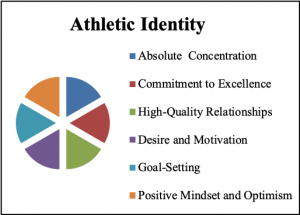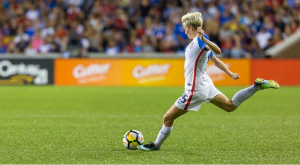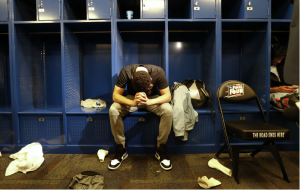By Lauren Wong, Masters of Education Student, BU Wheelock, Counseling & Sport Psychology Program
Across the globe, the COVID-19 pandemic persists in disrupting normalcy. For athletes, this means everything from working out in masks, to losing access to facilities, to cancelled and postponed seasons. There are so many losses along this spectrum of change for athletes, and grief is inevitable. How can we, as sport psychology professionals and those supporting athletes, help them manage their grief through this moment in history?
Grief and athletes
First, we must understand how athletes grieve. The most popular framework for the experience of grief is the Kübler-Ross model (1969) which details five stages of grief: denial, anger, bargaining, depression, and acceptance. The Kübler-Ross model has been applied to athletic populations before (Poel & Nel, 2011), and it can be useful in understanding the unique experience of grief for individual athletes.
However, in the context of sport culture, athletes often choose to inhibit their emotional reactions and disclosures for fear of appearing weak. As the Kübler-Ross model was developed in a clinical setting, it does not account for the contextual influences athletes are under. A newer theory shows that grief may be experienced as a social emotion. Jakoby (2012) places experienced grief in an individual’s social context, by which the reactions of others may influence the reactions of the individual. With the culture of sport having such a strong presence in an athlete’s context and identity, this theory may provide better insight to grief in athletes than Kübler-Ross’s model.
Much of the work related to grief and sport comes at the intersection of athletes and injury. Evans and Hardy (1995) reviewed all literature on sport injury and grief that was available at their time. They identified a different sense of emotions that athletes may encounter postinjury, including feelings of being cheated, devastation, restlessness, despair, and a need to reorient themselves post-trauma. The experience athletes can have with traumatic injuries may closely parallel their current unprecedented circumstances. In this sense, we can adapt the literature of grief and injury to help us identify concrete ways of helping athletes through the pandemic.
Write it out
There is evidence for the improved psychological well-being of grieving athletes using writing as a post-trauma intervention. For athletes dealing with long-term injuries, writing using Pennebaker’s written disclosure paradigm reduced feelings of devastation and despair (Mankad & Gordon, 2010). Pennebaker’s paradigm details that writing about one’s experience of a traumatic event does not improve coping simply by reliving the trauma; it does so by giving the individual control over their narrative through the process of choosing how to describe the event.
 For athletes recovering from concussions, participation in online forums about concussions was effective (Cassilo & Sanderson, 2018). Interpreted under the Jakoby theory (2012), concussed athletes often struggle with psychological distress due to social pressures and stigma that surround concussions. By entering an online community in which the taboo nature of talking about one’s concussion experience is removed, feelings of social isolation are reduced, thereby moderating the effects of a grief response.
For athletes recovering from concussions, participation in online forums about concussions was effective (Cassilo & Sanderson, 2018). Interpreted under the Jakoby theory (2012), concussed athletes often struggle with psychological distress due to social pressures and stigma that surround concussions. By entering an online community in which the taboo nature of talking about one’s concussion experience is removed, feelings of social isolation are reduced, thereby moderating the effects of a grief response.
Providing athletes with a structure for journaling that follows Pennebaker’s paradigm may be incredibly helpful to athletes. In the Mankad and Gordon study, the participating athletes were asked to write about their injury continuously for 20 minutes a day for three consecutive days (2010). Providing the task of 20 minutes of writing per day is an intervention that we could suggest to any athlete regardless of the resources that may be available; all they would need is a something to write with and something to write on.
Several online platforms that share the stories of current and former athletes exist as well. Think Players’ Tribune for collegiate and high school athletes. While athletes can submit their own stories to be posted, just reading the stories of others on the platform can increase a sense of community. At my undergraduate university, the athletic department started the “In Their Own Words” series for athletes and coaches alike to share experiences of COVID loss with peers (Wong, 2020). Formal and informal spaces in which athletes can take control of their narratives should be provided not only for this liberation through expresssion, but also to build a community of individuals with similar expereinces—something increasingly important in a time of social distancing.
There is no knowing what the future holds for the world right now, let alone what the landscape of athletics will look like in the future. In order to support athletes, we need to understand how they may be grieving. We should encourage athletes to write about their experiences of grief in this time of uncertainty and allow them to air out their disappointment, anger, and saddness in spaces of community. Above all else, we need to be there to support them in navigating this unprecedented time.
References
Cassilo, D., & Sanderson, J. (2018). From social isolation to becoming an advocate: Exploring athletes’ grief discourse about lived concussion experiences in online forums. Communication & Sport, 7(5), 678-696. doi:10.1177/2167479518790039
Evans, L., & Hardy, L. (1995). Sport Injury and Grief Responses: A Review. Journal of Sport and Exercise Psychology,17(3), 227-245. doi:10.1123/jsep.17.3.227
Jakoby, N. R. (2012). Grief as a social emotion: Theoretical perspectives. Death Studies, 36(8), 679-711. doi:10.1080/07481187.2011.584013
Kübler-Ross, E. (1969). On death and dying. New York, NY: Macmillan Publishing Company.
Mankad, A., & Gordon, S. (2010). Psycholinguistic changes in athletes’ grief response to injury after written emotional disclosure. Journal of Sport Rehabilitation, 19(3), 328-342. doi:10.1123/jsr.19.3.328
Van der Poel, J., & Nel, P. (2011). Relevance of the Kübler-Ross model to the post-injury responses of competitive athletes [Abstract]. South African Journal for Research in Sport, Physical Education and Recreation, 33(1). doi:10.4314/sajrs.v33i1.65496
Wong, L. (2020, April 22). In their own words: Track & field’s Lauren Wong. Retrieved November 22, 2020, from https://www.hornetsports.com/sports/track/2019-20/releases/20200422jdf9t3


